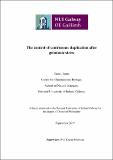| dc.description.abstract | The centrosome is the major microtubule organising center in animal cells. Following DNA damage, centrosome amplification can occur, which in turn can result in the formation of multipolar mitotic cells, and cell death. DNA damage-induced centrosome amplification requires G2-to-M checkpoint function. In the first part of this thesis, we tested if IR-induced centrosome amplification is allowed through a diffusible stimulatory signal or by the loss of a duplication-inhibiting signal, using cell fusion assays. Cell fusion experiments revealed that only the irradiated centrosome can reduplicate following IR treatment. These findings support a model in which centrosome amplification results from a centrosome-limited license to duplicate in G2 in response to DNA damage. In addition, we observed a notable increase in centriole disengagement following DNA damage, suggesting a link between IR-induced centriole disengagement and centrosome amplification. Moreover, pharmacological inhibition of Plk1 resulted in a decrease of centrosome amplification in irradiated cells, suggesting that Plk1 might be a licensing factor in IR-induced centrosome amplification.
Cep135 is a core centrosome protein that is important for the assembly and the maintenance of functional centrosomes in several organisms. In the second part of this study, we attempted to elucidate the role of chicken Cep135 in centrosome duplication and structure in chicken DT40 cells, using gene targeting. We found that Cep135-/- cells were viable and showed no obvious phenotypic differences in terms of cell cycle progression, mitosis and microtubule nucleation compared to wild-type DT40 cells. In addition, we showed that the loss of Cep135 does not cause any change in the overall centrosome composition, configuration and centrosome duplication, indicating that Cep135 is not an essential structural or functional component of centrioles in DT40 cells. Interestingly, ultrastructural analysis of Cep135-deficient centrosomes revealed an unusual electron-dense structure within the barrel of the centrioles. Furthermore, Cep135-/- cells displayed high levels of HU-induced centrosome amplification in comparison to wild-type DT40 cells, indicating that Cep135 deficiency causes DT40 cells to become more permissive to multiple rounds of centriole duplication. Together, the results presented in this thesis provide new insights into how cells control centrosome duplication after genotoxic stress. | en_US |


